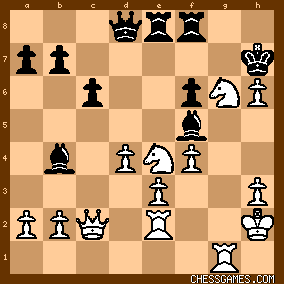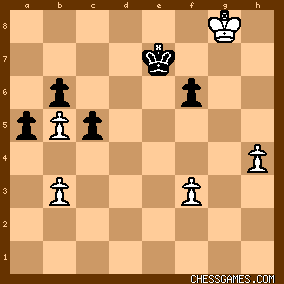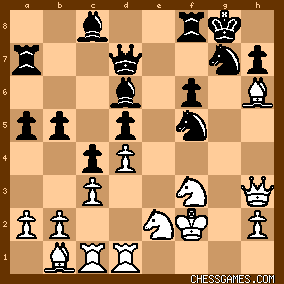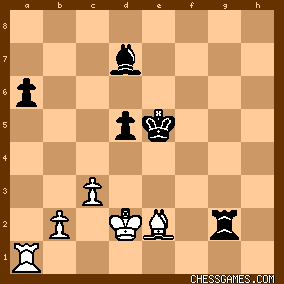|
Jaffe
Charles Jaffe had emigrated from Russia to the United States in 1896, and settled in New York City. At the age of 31, he became a professional chess player having previously worked in silk manufacturing, a branch of trade known for low wages and exploitative use of immigrant labour 1 "The Crown Prince of East Side Chess was and still is Charles Jaffe. It is impossible to convey the weird type of game he used
to play and the respect it won him among the cohorts along the avenue. If ever a man held court around a table, it was this very dark, slender, cigarette-smoking gypsy...Jaffe kept up a running fire of caustic badinage and could give amazing odds to the potzers... The ability to play coffee-house chess was one in which Jaffe surpassed any master. Coffee-house chess depends on an alert ingenuity in waylaying the opponent through subtle little traps or swindles... Unhappily, once the crown prince left the avenue he was not so invulnerable. Invite him to a tournament among his peers, take away his magic banter and force him to face sound, scientific chess, and his traps proved of little avail. Traps were often his own undoing. What we call playing for position—a damnable modern invention—was something his valiant combinations couldn't penetrate. The extreme caution of modern chess wore down his temperamental inspirations." 2 In 1909-10, Jaffe began a concerted attempt to build a professional chess career. In February 1909, he challenged Marshall to a match losing by 3.5 to 5.5 - Marshall - Jaffe (1909) . He came third in the 22nd New York State Chess Association Championship (1909), July 26-30, 1909, where he defeated Marshall - Marshall vs C Jaffe, 1909. He was third equal behind Capablanca and Marshall Game Collection: 1911 New York Masters (January 1911), but then his deficiencies were painfully laid bare in his first taste of elite grandmaster chess at Karlsbad (1911) . Having raised his fare by a public subscription, he found himself was outclassed, sharing last place with (+8 -16 =1). Jaffe was undeterred. He had a great faith in his own ability and lacked respect for many of his contemporaries. In a court case, soon after the end of this match, "Jaffe was asked to give his estimate of a number of noted experts...with evident reluctance...(he) admitted grudgingly that they were either "pretty good players" or "fairly good" 3 In October 1912, he lost a three game match against Capablanca by 0.5 to 2.5. This defeat was but a trifle in comparison to grave damage Jaffe's putative career was about to receive from the same Capablanca. The Cuban maestro made a public allegation that at the Havana (1913) tournament Jaffe had thrown a game - C Jaffe vs Marshall, 1913 . This point had enabled Marshall to win the tournament. Capablanca thereafter refused to play in any tournament where Jaffe was entered as a contestant and Capablanca's powerful supporters in the East Coast American chess establishment, Hartwig Cassell and Hermann Helms, concerted this embargo on Jaffe. Marshall, however, "employed him as an instructor at ... Marshall's Chess Divan..." 4. Despite, his ongoing problems with Cassell and Helms, in 1916, Jaffe raised sufficient funds to challenge David Janowski to this match. Janowski:
The 47 year old David Janowski had been stranded in 19th DSB Congress, Mannheim (1914) at the start of the First World War. Still holding a Russian passport, the German authorities interned him as an enemy alien. He had eventually made his way to Lausanne, Switzerland, and then persuaded a sympathetic Russian consul to grant him travel papers to the United States as he had a life-line - an invitation to the Rice Memorial (1916). He saw no possibility of making a living in Europe, and considered that "international chess in Europe was dead for at least twenty years to come". 5 He disembarked at New York on Tuesday, January 11th, 1916 and within a week was playing in the above tournament. After a two week break, on the 25th February 1916, he began this match. Jaffe and Janowski had only played twice before, in Havana 1913. Both games were drawn although Janowski had squandered a winning position with White. "If, you receive second prize," said Jaffe to Janowski during the progress of the recent Rice Memorial Tournament; "I shall challenge you to a match." and sure enough, the day after the tourney was over and Janowski had secured second place to Capablanca Jaffe opened up negotiations, the result being a match of five games up, draws not counting, for a purse of $400. 6 This would be about $7,000 in 2015 values. It seems that Janowski did not take Jaffe too seriously as a opponent. He was to pay the price with his reputation being diminished by the close result. Before the match with Jaffe had even begun, Janowski had already assumed his victory. On the day of the match's first game, he had challenged Capablanca and then put the letter out in the press: "My dear Mr. Capablanca - I have the honor to challenge you to a set match at chess of ten games up, drawn games not counting... with regard to the purse and stakes, time and place, and other details, I shall be glad to receive word from you at an early date". 7 Janowski was unsuccessful in eliciting any such commitment from Capablanca. Instead, in June 1916, Janowski challenged and lost a match to Marshall - Janowski - Marshall, 5th Match (1916) but then defeated the former American Champion Jackson Showalter - Janowski - Showalter, 4th Match (1916). Jaffe was given a second opportunity in November 1917. Janowski, apparently burning to expunge his unexpected defeat, agreed to concede his opponent odds of four games up in a match of ten. This time with his reputation at stake, Janowski overwhelmed Jaffe. The match:
The venue was Marshall's Chess Divan at Keene's Chop House, 70 West 36th Street, New York. "The conditions of the match are that the one who first wins five games, drawn games not to count, shall be the victor. The games are to be played at a rate of thirty moves an hour, and then a rate of fifteen moves to the hour. One game is to be played every second day, but in the case of a game being adjourned, it is to be concluded on the following day. The match is for a purse of $400." 8 <Felix E. Khan is stakeholder, the seconds being Robert Raubitschek for Janowski and George B. Sturrock for Jaffe. Jacob Bernstein is the director of play.> 9 Jaffe had White in the odd numbered games.
1 2 3 4 5 6 7 8 9 10 11 12 13
Janowski 1 0 0 0 1 1 ½ ½ ½ 1 ½ 0 1 - 7
Jaffe 0 1 1 1 0 0 ½ ½ ½ 0 ½ 1 0 - 6
<The games:>1st game - Friday, 25th February, 1916.
2nd game - Sunday, 27th February, 1916.
3rd game - Tuesday, 29th February, 1916.
4th game - Thursday, 2nd March, 1916.
5th game - Saturday, 4th March, 1916.
6th game - Monday, 6th March, 1916.
7th game - Wednesday, 8th March, 1916.
8th game - Friday-Saturday, 10th-11th March, 1916. Game reported as finished on the 11th 9th game - Sunday, 12th March, 1916.
10th game - Tuesday, 14th March, 1916.
11th game - Thursday, 16th March, 1916.
12th game - Saturday, 18th March, 1916.
13th game - Monday-Tuesday, 20th-21st March, 1916. Game reported as finished on the 21st 10.
The initial pace was frenetic with the first six games being decisive. Janowski had a dreadful start being 3-1 down and he did not manage to take the lead until Game 10. He was only ahead twice in the match before the final game. The average length of the games in this match was 66 moves, with nine of the thirteen games being over 50 moves. Game 1 was a scrappy game which Janowski won as Black. Jaffe tried to offer a coffee-house N sacrifice which Janowski simply ignored. Game 2 was more substantial with a well played opening leading to complications. Jaffe blundered with <25...Rg8> 
click for larger viewallowing Janowski to play <26.Ng5!> which should have won. Instead, he miscalculated, and then blundered again to lose in the middle game in which he had three connected passed pawns for a piece. Game 3 This was a long and equal game until Janowski made a very simple error in a K+P endgame and lost. 
click for larger viewJanowski played <66...a4> when <66... c4> would have held a draw 67.bxc4 a4 68. h5 a3 69. h6 a2 70. h7 a1=Q 71. h8=Q Qa8+ 72. Kh7 Qxf3 73. Qg7+ Game 4 Jaffe outplayed Janowski in the late middlegame and a passed pawn cost his opponent a piece and soon after the game. Game 5 Having lost three games in a row, this was a must win game for Janowksi. The game swung one way and then the other until 
click for larger viewwhen Janowski found <31...Ne3!> to obtain a winning advantage. Game 6 Late in the middle game, Jaffe first passed over a probably winning exchange sacrifice and then lost by allowing his opponent a simple but fatal tactic in an equal position. "After a lucky escape from a position in which his adversary had a certain win, but did not see it, Janowski of Paris defeated Jaffe ... Jaffe's chance came at the forty-second move, where, instead of playing RxN, giving up an exchange for a pawn and establishing a passed pawn, he retreated his knight and allowed Janowski to slip out of his tight fix...The ending, with a Knight apiece and pawns on the board was an interesting study, and Janowski gave an artistic demonstration of winding up the game..." 11 Game 7 A long game in which neither player could establish any advantage in a minor piece endgame. "In the ending Jaffe was left with a Knight against a Bishop, but, after vainly trying to accomplish something , the players agreed to a draw in fifty-eight moves..." 12 Game 8 Janowski had a promising position, but could only achieve a drawn Q+P endgame. Game 9 Janowski missed the key move to achieve a simple win of a piece after Jaffe had unwisely snatched a pawn in another lengthy ending 
click for larger viewHe played <65...Bb5?> instead of <65...Bg4!> 66. Re1 Ke4 67. Kd1 Rxe2 68.Rxe2+ Kd3 Game 10 Janowski played carelessly and allowed Jaffe to use his coffee house honed tactical skills to the full with a crushing attack on the king. This was Jaffe's best game of the match and also its shortest. Game 11 An ending of a Jaffe's Bishop against three pawns was indifferently played by both players, and exhausted itself into a draw. Game 12 Janowski worked up a winning attack and then dissipated his advantage. In an equal ending, he lost the thread of the game and went down to a loss. Game 13 Janowski broke through on the Q-side and won material. Jaffe played out a hopeless endgame looking for tricks but Janowski took the point the exchange and four pawns up. Contemporary reaction: Neither player emerged with credit they could have hoped for from this match. Fans are disappointed at the Jaffe-Janowski Match Games "Supposing that Charles Jaffe had really accomplished the feat of defeating David Janowski of Paris, the winner of several European International tournaments, and at one time during the progress of the contest it really looked as if he would easily win the match, the glory and the stakes, for he was then leading his adversary with three points to one, those who followed the contest game by game and who took the trouble of playing over the scores and also indulging in analysis, were utterly disappointed in every respect. They could not believe that the famous Janowski, who had only recently won the first brilliancy prize in the Rice memorial Masters' Tournament did play these games, overlooking win after win, and neither could they believe that Jaffe played up to his real form, for he too missed chance after chance, lost games which he should have won….Under the circumstances it cannot be said that the match was instrumental in contributing much to the theory of the game. It did not produce anything in the shape of originality, beauty or soundness, maybe with one or two exceptions… However, there is a lesson being taught to both of the players. Janowski must by this time have seen that even a reputed master player cannot afford to look down upon local talent for which he generally use the term "coffee-house player". He ought to remember that Charles Jaffe beat Jacques Mieses once a famous German expert 13 , while Jaffe should be reminded not to look upon Janowski as "Jachnetschik", a player whom he could "sink" like a fisherman or could "tear like a fish". 14 Notes:
1 See Wikipedia article: 1913 Paterson silk strike 2. "Chess Reclaims a Devotee" by Alfred Kreymborg, "The American Mercury", August, 1930, pp. 446-453 - PDF available at http://www.unz.org/Pub/AmMercury-19... 3. "The Brooklyn Daily Eagle", 5th April, 1916, p.23. 4. "The Brooklyn Daily Eagle", 5th April, 1916, p.23. 5. "The Brooklyn Daily Eagle", 12th January, 1916, p.20. 6. "The Australasian", (Melbourne, Australia), 22nd April, 1916, p.58> 7. "The Brooklyn Daily Eagle", 25th February 1916, p.24. 8. "New York Times", 21st February, 1916.
9. "American Chess Bulletin", vol.13-15, p.78. 10. Dates of Games 1-10 from the "American Chess Bulletin", vol.13, April 1916, No.4., p.78,"American Chess Bulletin", Vol.13 May-June 1916, No.5.,p.126. and from contemporary newspaper reports. 11. "Brookyln Daily Eagle", 16th March, 1916, p.20. 12. "New York Times", 9th March, 1916.
13. Jaffe beat Mieses (2.5 - 0.5) in three "exhibition" games in New York in 1907. It is questionable if whether to Mieses this constituted a serious match between masters. See "New York Times" December 31st, 1907. 14. "New York Sun", (New York), 19th March, 1916, p.11.
| 


